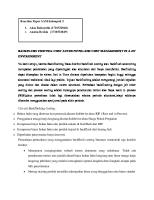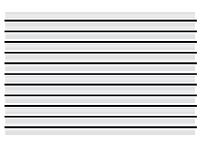White Paper c11 741490 12 13 [PDF]
White paper Cisco public Table 4. Mobile connections by network type – 2023 regional percentage share Region 3G and
31 2 205KB
Papiere empfehlen
![White Paper c11 741490 12 13 [PDF]](https://vdoc.tips/img/200x200/white-paper-c11-741490-12-13.jpg)
- Author / Uploaded
- Mohamed Aly Sow
Datei wird geladen, bitte warten...
Zitiervorschau
White paper Cisco public
Table 4.
Mobile connections by network type – 2023 regional percentage share
Region
3G and Below
4G
5G
LPWA
Global
29
46
11
14
Asia Pacific
23
52
13
12
Central and Eastern Europe
31
50
2
16
Latin America
37
50
2
16
Middle East and Africa
73
22
1
4
North America
1
45
17
37
Western Europe
13
43
16
28
Source: Cisco Annual Internet Report, 2018–2023
The top three 5G countries in terms of percent of devices and connections share on 5G will be China (20.7%), Japan (20.6%), and United Kingdom (19.5%), by 2023. Mobile IoT adoption—M2M The phenomenal growth in mobile end-user devices and M2M connections is a clear indicator of the growth of mobile IoT, which is bringing together people, processes, data, and things to make networked connections more relevant and valuable. Globally, mobile M2M connections will grow from 1.2 billion in 2018 to 4.4 billion by 2023, a 30 percent CAGR—a four-fold growth. (Figure 9). Figure 9. Global mobile Machine-To-Machine (M2M) growth
30% CAGR
2018–2023
5.0 4.5 4.4
4.0 3.5
Billions of Connections
3.5
3.0
2.8
2.5 2.0
2.2
1.5 1.0 0.5 0.0
1.6 1.2
2018
2019
2020
2021
2022
2023
Source: Cisco Annual Internet Report, 2018–2023
© 2020 Cisco and/or its affiliates. All rights reserved.
White paper Cisco public
Section 2: Network performance and user experience A. Wi-Fi continues to gain momentum One of the main solutions to meet the demands of the increasing demand for bandwidth has long been leveraging Wi-Fi networks, which enables operators to scale capacity to meet their subscribers’ needs. With advances and ratifications in Wi-Fi standards, dense environments with many concurrently connecting devices and IoT connections such as airports, public transportation, retail, healthcare, smart cities, stadiums etc. result in public wi-fi use cases across industry segments. Globally, there will be nearly 628 million public Wi-Fi hotspots by 2023, up from 169 million hotspots in 2018, a fourfold increase. Figure 10. Global Wi-Fi hotspot strategy and 2018-2023 forecast
Existing
Growth
• Pay-as-you-go • Free access promoting other services (Retail free Wi-Fi) • Managed services (venues and outdoor) • Cellular offload (user promoted) • Added value for broadband subscription • Advertising and sponsorship
Total Public WLAN + Community Hotspots
Future • Wi-Fi Capacity trading
• Cellular offload (carrier driven)
• Transaction platform
• Community Wi-Fi/homespots
• Internet of things
• Carrier-grade VoWiFi
• Context awareness
• TV everywhere
• HetNet Wi-Fi + mobile
• Large events
• Connected car (in-car Wi-Fi)
• Big data analytics • Public transportation Wi-Fi
2018
2023
169 M
628 M
Total Incremental Hotspots
?
Source: Maravedis, Cisco Annual Internet Report, 2018–2023
By 2023, Asia Pacific will have the highest share of global public Wi-Fi hotspots at 46 percent. Public Wi-Fi along with community hotspots are included in the forecast. Community hotspots or homespots have emerged as a potentially significant element of the public Wi-Fi landscape. In this model, subscribers allow part of the capacity of their residential gateway to be open to casual use. The homespots may be provided by a broadband or other provider directly or through a partner. Asia Pacific will lead in adoption of homespots. By 2023, China will lead in total number of homespots, followed by the United States and Japan. Figure 11. Global public Wi-Fi hotspots growth by region
30% CAGR 2018–2023
700
628
600
4% 9%
500
Millions of Hotspots
17%
400
23%
300 200
169
Central and Eastern Europe (38% CAGR) Latin America (37% CAGR) North America (25% CAGR) Western Europe (20% CAGR)
45%
100 0
Middle East and Africa (30% CAGR)
Asia Pacific (37% CAGR)
20 18 20 19 20 20 20 21 20 22 20 23
* Middle East and Africa represents 1% of global public Wi-Fi hotspots by 2023
Source: Maravedis, Cisco Annual Internet Report, 2018–2023 © 2020 Cisco and/or its affiliates. All rights reserved.









